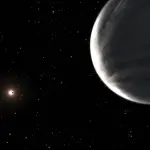Key Takeaways:
- Teenage Triumph: Wolf Cukier, a 17-year-old high school junior, made an astonishing discovery during his NASA internship.
- Unprecedented Find: On just his third day, Cukier identified a new exoplanet, TOI 1338 b, using data from NASA’s TESS satellite.
- Unique Characteristics: TOI 1338 b is 6.9 times larger than Earth and orbits two stars, making it a rare circumbinary planet.
- Scientific Breakthrough: This discovery highlights the valuable role of citizen science projects and human observation in space research.
- Bright Future: Cukier is now considering prestigious universities like Princeton, MIT, and Stanford for his future studies.
In a remarkable turn of events, a 17-year-old high school student, Wolf Cukier, achieved a groundbreaking discovery during his summer internship at NASA. Hailing from Scarsdale High School in New York, Cukier’s journey to scientific stardom began when he secured a two-month internship at NASA’s Goddard Space Flight Center in Greenbelt, Maryland, during his junior year.
Cukier’s initial task was to analyze variations in star brightness recorded by NASA’s Transiting Exoplanet Survey Satellite (TESS) as part of the Planet Hunters TESS citizen science project. This initiative enables non-NASA volunteers to contribute to the search for new planets. Remarkably, it was on just his third day that Cukier stumbled upon a celestial gem.
This celestial discovery, named “TOI 1338 b,” was formally announced by NASA, following rigorous confirmation of the teenager’s findings. Cukier co-authored a scientific paper, which underwent a peer review process, culminating in the announcement of this exoplanet at the 235th American Astronomical Society meeting.
Cukier recounted his eureka moment, stating, “About three days into my internship, I saw a signal from a system called TOI 1338. At first, I thought it was a stellar eclipse, but the timing was wrong. It turned out to be a planet.” This revelation stemmed from a subtle dip, or transit, in the brightness of the TOI 1338 system, which was unlike anything seen before.
TOI 1338 b possesses extraordinary characteristics. It dwarfs Earth, measuring 6.9 times its size, residing in the distant constellation of Pictor, approximately 1,300 light-years away from our planet. To put this into context, our Sun is a mere seven to nine light-minutes away from Earth. This newly discovered exoplanet is a circumbinary planet, indicating that it orbits not one, but two stars, which themselves orbit each other every 15 days, with one star being 10% larger than our Sun.
In Cukier’s own words, “I discovered a planet. It has two stars which it orbits around. So, if you think of Luke’s homeworld, Tatooine, from ‘Star Wars,’ it’s like that. Every sunset, there’s gonna be two stars setting.” Cukier, an avid “Star Wars” fan, even has “Star Wars” posters adorning his bedroom walls, further fueling his passion for the cosmos.
The significance of Cukier’s discovery extends beyond just this newfound celestial body. It underscores the challenges in identifying circumbinary planets, which can often be misinterpreted as eclipses by standard software. The human eye, as demonstrated by Cukier, excels at recognizing patterns in data, especially those that lack regularity.
With this historic achievement under his belt, Cukier is now setting his sights on higher education. He has named Princeton, MIT, and Stanford as his top choices for further studies, signifying a bright future ahead for this young astrophysicist.


